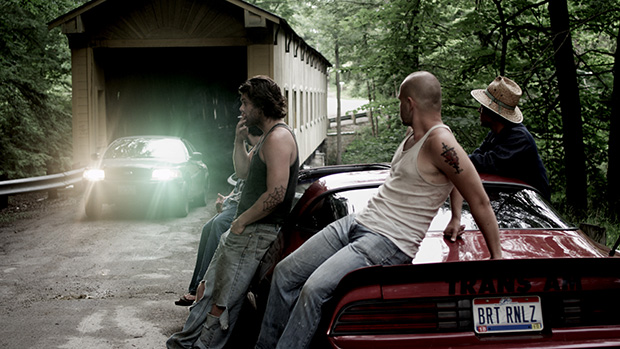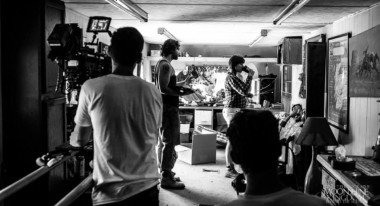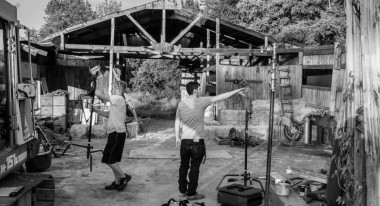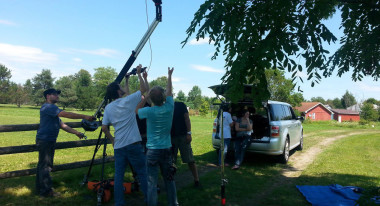 Back to selection
Back to selection
Creating Moonshine Kingdom: An Interview with Milton Horowitz and Ryan Forte
 Moonshine Kingdom
Moonshine Kingdom Mooshine Kingdom director Milton Horowitz says that, like a lot of Americans, he grew up watching too much television. This eventually led to film school at Cleveland State University, where he met cinematographer Ryan Forte. “Ryan’s younger than me,” says Horowitz. “He’s 21, I’m 32, and even though we’re 11 years apart we still love the same types of films and the same movie techniques.”
While this is ostensibly their first feature film, Forte says he tried to make a feature film when he was younger that became “way too long. I sent it to a film festival and it got turned down and now I’ve just kind of buried it and don’t ever plan on showing it again.” Forte and Horowitz made some short films together before deciding to make a feature film. The two of them assumed most of the major roles in production, with Horowitz writing and directing it, while Forte acted as both cinematographer and editor.
Moonshine Kingdom debuted at the 2013 American Film Market and is being distributed by Nanotech Entertainment on their UltraFlix UHD 4K streaming network.
Filmmaker: Where did the idea for the film come from?
Horowitz: We had been doing commercials and the guy who was paying for them decided that he wanted to make a film. We were searching for different ideas of narrative topics that are popular and we felt that the Amish and moonshine were subjects that were really popular right now; there’s television shows on both topics. So we wanted to focus on those topics but we didn’t know exactly how. We didn’t really know anything about Amish people other than what they tell you on TV.
I have an uncle who owns a farm near an Amish community, so I went out there and started talking to him about what we were doing. We really liked his property. We knew that if we were shooting a film with a low budget and we didn’t have huge actors in our film, we had to at least have beautiful scenery and stunning vistas. Huntsburg, Ohio offered that; it’s so beautiful and green and very untouched.
He also shared a story with us about an individual that he met in Vietnam, an Amish medic that was a good friend of his. He had left the Amish community when he was 15 and he had no work history, so no one would give him work except the government. While he was in Vietnam, he realized he made a big mistake and that he wanted to go back to the Amish community, but when he got back from the war the Amish community wouldn’t take him back because you’re not supposed to take up arms in a war.
Filmmaker: What was this shot on?
Forte: We had two RED One systems that were fully kitted out that came from Fletcher Camera & Lenses in Detroit. That’s what we shot the first 60% of the movie on. We finished the movie on a RED Scarlet. We shot RED Code RAW 4K and we used 8 to 1 compression.

Filmmaker: Why the switch with the cameras?
Horowitz: That wasn’t planned. What happened was we ran over budget and we had to raise more money. We had originally rented the equipment for 18 days. We were shooting in Huntsburg in June, in one of the hottest months there, and we ran into unfortunate weather problems. It rained almost every day and we had three or four days that got completely washed out. We realized we still had three more scenes to shoot but the cameras weren’t available for rent, so it wasn’t really pre-planned that we would use two different cameras.
Filmmaker: Did you have any problems dealing with the footage from the different cameras?
Forte: I wouldn’t say I had problems matching because of the cameras, but the opening scene in the barn was extremely hard to color grade because of changing sunlight. Most movies with bigger budgets flag or bounce sunlight and fill with big HMI lights to keep lighting as consistent as possible. We had to work with natural light a lot during production of the film.
I feel like too many people want to buy a camera and if you think about it, with our budget for camera rentals we got essentially $150,000 worth of gear for what you’d spend just on an FS700 body. That’s part of why our production values are so high. Most people are too attached to owning things and that’s your worst enemy. If you buy a camera, you’ve just spent $7,000 on the camera, but what about lenses, what about matte boxes, what about your recorder, what about extra monitors, tripods, dollys and jibs? All the stuff, you’ve got to get if you want to make a good movie.
Horowitz: Saving money on our equipment budget was definitely key to the movie having the high quality picture value that it does. I would definitely say that if it wasn’t for the high quality camera and the high quality of production value, we would definitely have been overlooked by distributors.
Filmmaker: What was the total length of time you were shooting?
Horowitz: We shot for 18 days, and then we shot for two alternate weekends for 24-25 days of total shooting.
Filmmaker: You were shooting mostly on location?
Horowitz: The film was shot mainly in Huntsburg and Cleveland and we had a lot of help. Everybody who worked on the film, even though it was low-budget, was extremely interested and very dedicated to the project.
There’s music from a band called Strange Changes that’s based out of Boston, and they’re mostly made up of Berklee [College of Music] students. It’s really like a crazy New Wave Jazz Fusion kind of music. Blind 7 Photography is a photography and makeup studio that helped us do a lot of effects, and Vector Aviation let us spend hours with their airplane trying to see how we could mount the camera in different ways.
Filmmaker: How many cast and crew were there?
Horowitz: Most of the time the crew was around 11 or 12 people each day, but I think the entire head count of everyone that worked on the film turned out to be 26 or something like that.
On the first day of filming we got our bus stuck in the street in the mud and the Amish couldn’t get through with their carts and horses. They were all standing on the side of the road watching us try to get this bus out of the mud, and we went over and I started talking to them. We met this Amish kid and were asking if we could just talk to them, learn some more things, and they agreed to met us and speak with us.
We were supposed to meet them after a baseball game they had one day. He called us early saying, “We can met you guys earlier, the other team didn’t show up so we couldn’t play baseball today.” I looked around and I realized we had exactly 11 people as cast and crew. I said, “These Amish kids just lost their baseball team, do we want to go play baseball against the Amish?” We went out and met them and we started playing baseball and all these older Amish guys showed up and got really angry at the Amish kids and kicked us out.
Filmmaker: How was it edited?
Forte: We had a desktop that I built on-set in an attic, and it was a combination of me and one other person who was sometimes a DIT and helped me out. We would log the SSD mags into the computer and we’d make two or three copies depending on how many hard drives we had available. Then we started cutting together sequences at night. By the time we finished shooting we had about a quarter of the movie done. We had sequences cut together, they weren’t finished and completely composed but they were in the timeline. It was edited in Adobe Premiere Pro Creative Cloud on Windows 8.1.
Filmmaker: How long were you in post after you finished shooting?
Horowitz: We wrapped production August 1st and we had screeners ready by the time we made it to AFM [American Film Market] in November. I think it was about three quarters of the way edited in November when we went to AFM and I think we finished it by December. So we turned the whole movie around in five months in post.
Filmmaker: Looking back, is there anything you would do differently?
Horowitz: There’s so many things we’d do differently. Half the things went wrong. The most difficult thing about shooting on a low budget is that when problems arise you don’t have a lot of money to throw at them to make them go away. I think every filmmaker says they should have raised more money, but that was definitely the hardest part.
The thing we had to be the most flexible about was the story. I know writer-directors who don’t want to change things if for some reason something goes wrong. They’ll just reschedule it for another day and make it take longer and longer, and I definitely didn’t want to be one of those filmmakers who is constantly working on a low budget movie until it’s perfected. It’s never going to be perfect, it’s a low-budget movie, so we had to reinvent things as we went long.
I’m not proud to say that only about 50% of what I wrote before we started shooting made it into the film. The other 50% of the film we had to make up on the spot. I literally rewrote entire scenes with the cast sitting around me waiting for me to hand out their lines. And this is only because things would go wrong, people’s schedules wouldn’t work, and our deadline was to make it to AFM by November.
Forte: I would definitely have more people on hand for DIT. Unfortunately we didn’t have union labor, so we didn’t have people that were skilled with the cameras we were using. I was the only person that truly understood how these cameras were built, how to put them together, how to break them down, how the workflow worked as far as editing. I had to teach as much as I could to these people and then monitor them and micro-manage everything. I definitely wish we would have either hired people who knew more about the systems or spent a lot more time with these people before we shot and taught them everything they needed to know.
Filmmaker: What are you working on right now?
Horowitz: We have a new film that’s coming out. We’re under a nondisclosure agreement and we’re not allowed to talk about too much of it, but it’s definitely going to be another film that is on the edge of technology. It’s going to be shot in 6K and will be shown in 4K.



